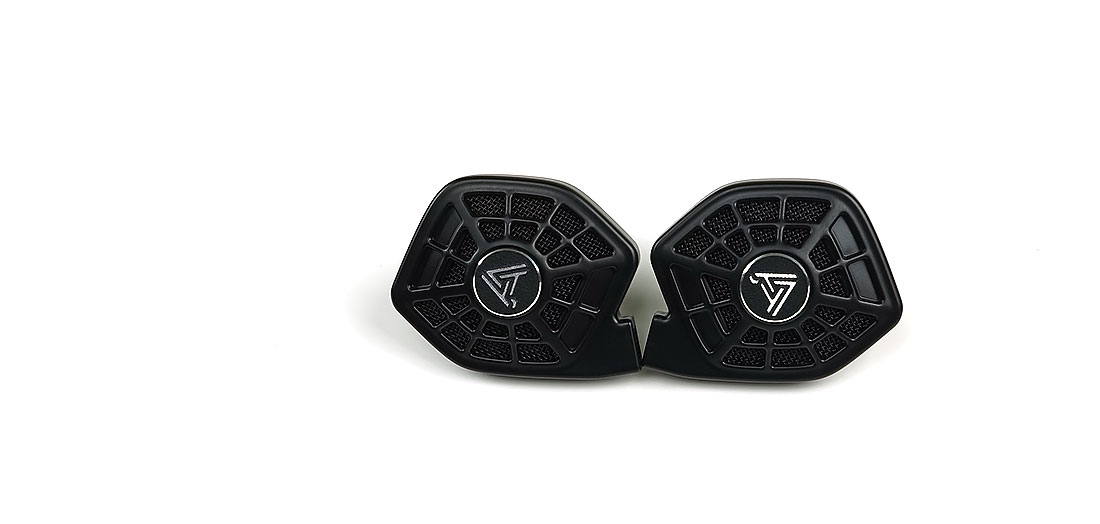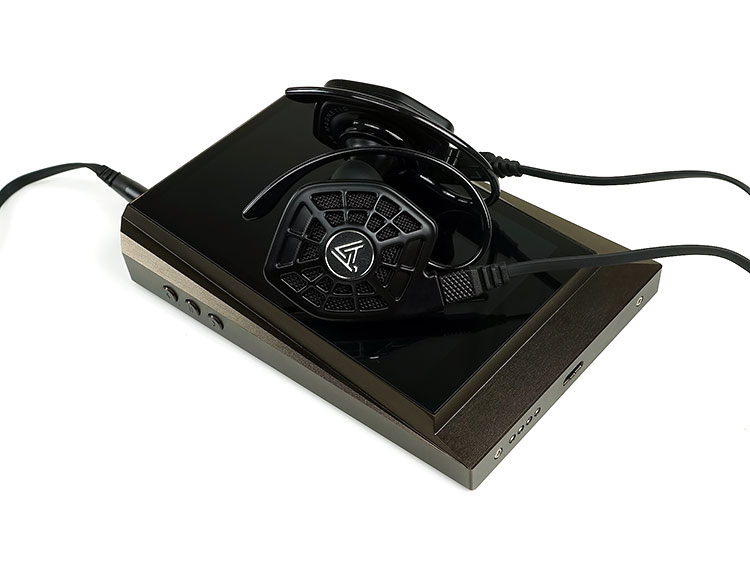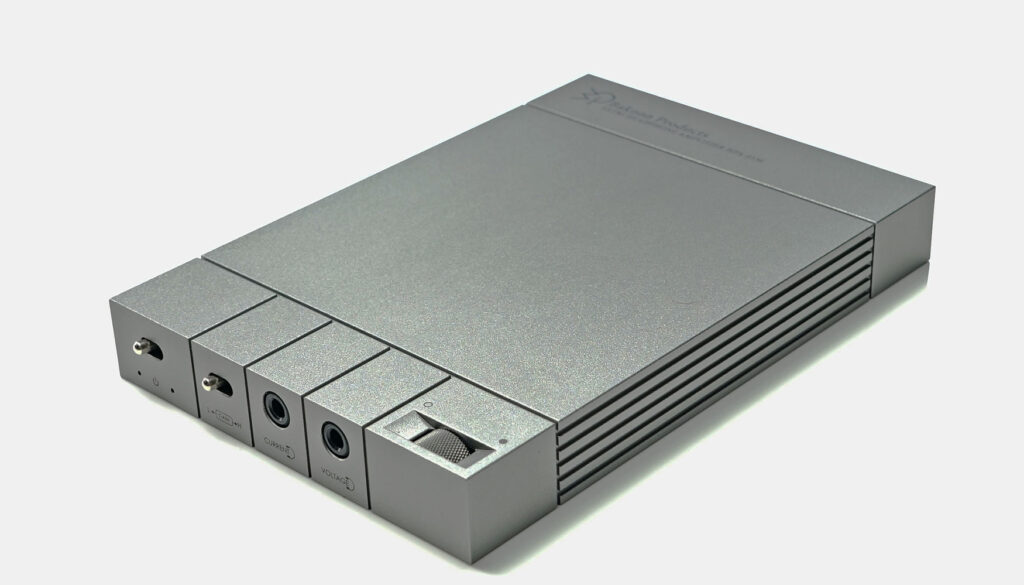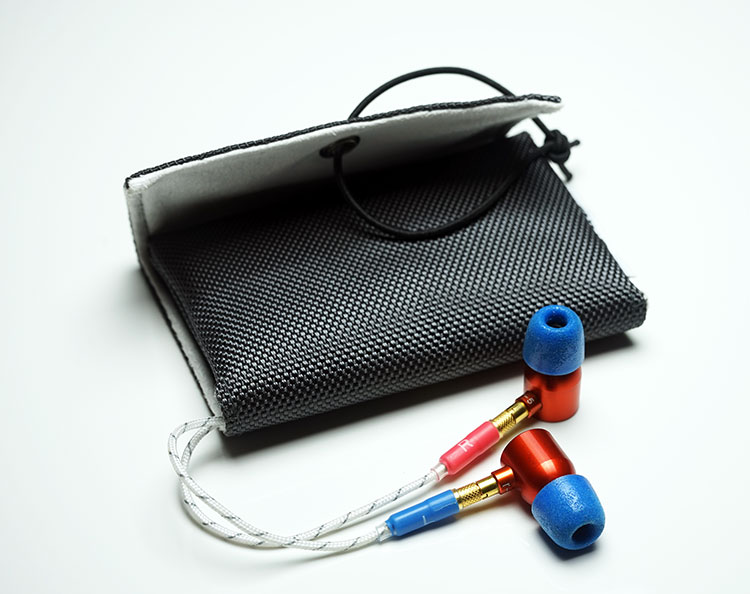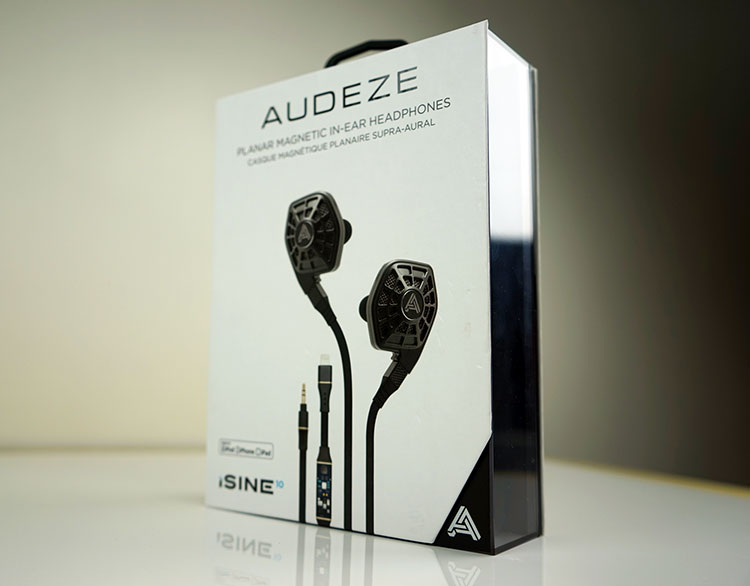Sound Impressions
Tonality & Presentation
The tonality of the iSINE 10 is variable to some extent, particularly with the two cables and what they can do. At heart the iSINE 10 is a very musical sounding presentation with a very airy and spacious but definitely a planar sound primarily due to the open design. This marks it out as something quite different to the majority of other IEMs out in the market today. The key difference between the two cables is really the clarity and top end extension.
Analog
With the analog cable I found a warm to natural but lively tonal quality that shifted slightly depending on the source in terms of richness but otherwise delivered a fairly distortion free experience. Staging is wide and spacious with an out of head feel but it lacks a little height with the analog cable which presents more of a bass to mid-centric quality to its presentation than the Cipher cable.
Cipher
The Cipher cable, with its DSP magic, pushes forward the treble, brings in a little bit more dynamic contrast, particularly with vocal spacing and introduces a bit more sub-bass presence and impact.
If the analog cable is the easy going cable, then the Cipher is the more energetic and possibly the more balanced of the two when compared side by side from a compatible iSource. The analog cable really comes into its own when you scale up and being true to its planar design the iSINE 10 can take decent power and sound better as a result.
Personally, I think the immediate impact will always be the DSP baked Cipher cable with its perceptibly more balanced presentation but matched with the right amp and source I think the analog can do some great things also.
Bass
With the analog cable, the iSINE 10 low-end was impactful, clear and well defined with excellent sub-bass extension and presence.
It is perhaps weighted more to the sub-100Hz sub-bass performance so kick drums have a solid impact and weight but the rest of the curve didn’t exhibit any signs of mid-bass bloom or over cooked warmth muddying up the excellent level of clarity in the upper bass and lower mids.
Overall it has a fairly linear and clean sounding performance from 100Hz onwards with a fairly gentle drop to the mid-range. The fundamentals also are excellent giving the iSINE 10 a healthy dose or PRaT and injecting some welcome power and musicality into lower pitched instrumental notes.
Cipher Bass
Bass performance using the Cipher cable is far more aggressive with a definite dB uptick from the sub-bass up to the mid-bass response. This is slightly less linear in presentation but at the same time more engaging and dynamic sounding. Bass fundamentals with the analog cable were good, accurate and weighted but the Cipher cable sounds much more planted and visceral.
If you want some additional depth to your staging then use the Cipher cable. You lose none of the speed and detail in the process which makes it more ideal for metal and EDM.
Mids
I really love the timbre of the iSINE 10 mids on the analog cable. It is a perfect match to hard rock and metal with a crunching full blooded but clean sounding lower midsection, just perfect for a Les Paul to show off its rhythmic magic.
It doesn’t quite have the level of resolution and control of some of the TOTL multi-BA designs out there and it lacks a little in the way of holographic imaging but it has excellent width with a generally more forward mid-range performance akin to a live small concert hall feel.
One thing for sure this is not an analytical or lean performance, it is highly musical and at times euphoric sounding. A hint of warmth combined with solid fundamentals adds a fantastic sense of power to its instrumental presentation without ever coming off as overblown.
Vocals vary a little for me and again this is related to source and power and at other times it is really the source track. On some brighter mixes using the iTouch the analog cable would slip in a bit of sibilance on higher pitched vocal attacks, and at other time sit sounded wonderfully natural and smooth sounding.
Cipher Mids
Using the Cipher cable the mids sounded a little cleaner than the analog cable and also with a little less warmth in the timbre but it still had that authoritative lower mid-range power, perhaps even more so with the sub-bass dB increase.
Instrumental layering and separation are a little clearer than what the analog cable offered, particularly using an iGadget such as the iTouch. The analog cable is capable of a superior performance on better amps but on this platform, the Cipher cable produces the more holographic staging quality and superior imaging.
Vocals have slightly better spacing, sounding a little more formed also. The better treble response doesn’t push down quite as much on the upper mids as the analog cable tended to do on the iTouch.
Treble
Treble on the analog cable is a little more relaxed sounding than the Cipher cable with less brilliance emphasis and a slightly harder tone particularly when transitioning from the upper mids and into the lower treble.
That boost of energy moving up from the vocal range peaks around 5-7k though not by a huge margin so it doesn’t sound hot. It is more of a slight lack of body combined with a partial overtone that can make its presence felt at times on cymbal crashes, tambourines, some higher pitched female vocals.
Some of this may be power related though. Feeding a better amp signal using the analog cable with the Chord Mojo, which packs a decent punch, did fatten up the lower treble body a bit more than an iTouch amp and the resulting percussion timbre, whilst a touch glassy still, sounded a lot more natural and pleasing to the ear.
Cipher Treble
The DSP inside the Cipher brings the whole treble response on the iTouch further forward than the analog cable and adds a bit more substance and note body in the process.
Upper mids to lower treble is still energy dominant and it still has a little hardness but there is better final octave extension beyond 8k that adds to an airier sound with a bit more sparkle.
Matchability
Efficiency
If you are using the Cipher cable you will be limited to an igadget of some sort so the internal DAC/Amp from the iSINE 10 cable will look after everything. This is a noise free experience with decent gain and will drive the iSINE 10’s pretty good actually and certainly one of the better pairings I have had with an iTouch.
DSP/EQ
The baked in DSP also lifts everything considerably beyond jacking in with the analog cable as described in our sound impressions. The use of the Audeze app with its real-time EQ functionality is also a handy edition. I do like it, it lifts the gain a touch and adds some impressive responses particularly with the bass control which I sometimes turn to using this pairing.
Analog Power
With the analog cable on an iGadget, I thought it comparatively weak sounding and lacking in upper mids and lower treble body. This is a planar driver after all and even at 16 ohms and 120dB rating, the iSINE 10 can still suck up plenty of output power, especially if it is matched with gain control that is not super aggressive. Basically with the analog cable pair it with a quality DAP or portable amp to make it shine.
Analog Pairings
The Bit Opus#3
$849
This is a relatively smooth sounding pairing in low gain with a mid-centric bias. You can elect also to switch up to high gain without any present noise.
The amp though in the Opus#3 is not the strongest at 140mW x 2 compared to equivalent DAPs and portable amps so it tends to exhibit a slightly glassy upper mids and lower treble on some percussive passages and a hint of sibilance on the upper mids. This is similar to what I found using the analog cable with an iGadget setup though the details levels are much higher and you do get a more refined presentation.
Shozy Alien+
$435
I tended to prefer using the mid gain setting on Shozy’s new Alien+ DAP just to get a bit more gain control on the rotary analog pot. The iSINE 10 really does much better with superior power output using the analog cable and in the case of the Alien+, it is superior to the Opus#3 for power.
This is a clear and natural sounding response with a smoother vocal delivery and outstanding detail retrieval. It is, however, more neutral sounding than the Opus3# and in some instances that little hard sounding lower treble creeps in on some brighter or busier tracks.
Overall though I prefer the Alien+ stock sound compared to the Opus#3 with the iSINE 10. Graphical EQ on the Opus#3 can bring out some areas that the Alien+ can’t though such more low-end fullness or a more subdued lower treble.
Astell & Kern AK380
$3,499.00
Noise and power wise the AK380 does perfectly fine with the iSINE 10 and in fact, it is one of the most refined pairings out of the DAPs I had tested. It will push up the gain a touch at around 80 – 95 which is quite a bit higher than a lot of other IEMs bar the RHA 150ohm monsters.
Considering both have similar DACs it is not that surprising that the AK380 has a very similar tonal presentation to the Alien+. The main differences for me with the AK380/iSINE 10 is just a touch more body in the upper mids and lower treble than the Alien+.
The AK380 also has a softer attack on the iSine 10 but not as soft sounding as the Opus#3 so you get decent ‘bite’ in percussive sequences. Vocals on the iSine 10 are also a bit more forward with the Alien+ than the Ak380 and sound a bit more lively.
Cayin I5
$399
The i5 has a bit more power than the Opus#3 also and here it starts to cope up with the trace of sibilance found in the weaker Opus#3 producing a more natural sounding upper mids and lower treble. It is still energetic but not as brittle sounding.
This is a musical match with a more aggressive low end than the Alien+ or the Opus#3 but with less detail and texture than the more refined AK380.
Custom EQ settings using the I5 worked really nicely with 6dB sub bass increase followed by a linear drop of 4dB gradually to 1k. Then a 2-4k hump with a gradual drop off post 5k as well as a tiny bump at 12-14k. This played really nicely on the iSINE 10 with trance, EDM, and modern pop/rock and provided some excellent depth to the iSINE 10 performance.
Bakoon HPA-01M
$1295
This is some serious magic sauce and I love this pairing. It fattens out the treble note body of the iSINE 10 with the analog cable but keeps everything else tight and well defined.
This is a seriously smooth and quick pace presentation with excellent resolution, zero noise, and impressive dynamics. Be warned though you do need to high gain to get the best level of gain control which is similar to how the LCD series full sizes planar headphones worked with this portable beast.
I actually find this a more natural sounding and refined presentation than the Cipher cable on the iPhone. If I want some EQ I can just input it from whatever source I am using with the Bakoon.
The HPA-01M still seems to be king of portable amps for planar pairing and its impressive credentials for the LCD range translate easily to the iSINE 10.
Select Comparisons
oBravo ERIB-5a
£319.00
Technicality
The ERIB-5A is a hybrid planar IEM in a more traditional build design with a single planar tweeter and a dynamic driver. It is far more power hungry than the iSINE 10 at 16 ohms and 102dB sensitivity rating and generally speaking I find I am powering up the oBravo on big amps like the Bakoon HPA-01M and even the Cypherlabs Sustain84 to get the most out of them.
In terms of form factor, the oBravo’s are more traditional in design and as such is a comfier over the ear fit than the iSINE 10. They also come with a balanced cable option, something I would like to see in the iSINE range.
Tonality
Tonally the iSINE 10 outperform the ERIB-5a by a considerable margin. Staging is more open and spacious on the iSINE 10 with an out of head experience making the ERIB-5a sound a little one-dimensional and “small” in comparison. Only the ERIB-5a’s smoother upper mids and better lower treble body comes in slightly ahead due to its better body but even then the detail is just a bit lacking for me.
The oBravo’s low-end response is also a reserved and not as deep or powerful sounding as the iSINE 10. Vocals on the oBravo though are natural sounding and a bit more forward than the iSINE 10. However the details and dynamics are just not as enticing or engaging, you really do have to pump the power in the ERIB-5A to get close.
Baby Stax SR002
$490
Technicality
If any IEM even comes close to remotely resembling the iSINE 10 and its basic design then it is the Stax SR002.
The shape maybe a bit more vanilla and just stick in your ear rather than use detachable hooks but the shell design is similar. You can elect to attach a headband on them though which does help. In short, they are an open design electrostatic IEM but like the iSINE 10 planar IEM, they sit outside your ear with a nozzle and tips to deliver the sound, seal, and level of comfort.
Though an improvement on the SR001 classic, the SR002 is still an uncomfortable fit for me with pressure placement still relatively off and the nozzle a bit thicker. The iSINE 10 is a better design in that regard and more comfortable in the ear. You still need a good set of tips to work with the SR002, much like the iSINE 10 a lot of the seal and final comfort levels will depend on the tips. Isolation on both is low to non-existent.
Tonality
Tonally both have good mids but overall these are very different signatures. The electrostatic sound is at its warmest and most mid-centric with the SR002 but it still lacks height and depth as well as the sheer physicality compared to the more planted iSINE 10.
The bass however on the Stax is fast and very detailed, somewhat faster than the iSINE 10. On balance, though I would take the substance and body of the iSINE 10 bass response over the speed of the Stax for the power and rumble it can deliver. The same pattern for the mids with the Stax favoring a clean and detailed presentation with very precise control and imaging over the iSINE 10’s richer timbre, better fundamentals, and sheer musicality. The Stax has a cleaner less brittle lower treble, I find the upper mids and lower treble to be just a bit more refined than the iSINE 10.
The Stax does have a nice spacious and smooth delivery much like the iSINE 10 but lacks that depth and headroom and even the relaxed analog cable of the iSINE 10 bests it for extension. For genre matching, I would take the Stax more for a roll on audiophile recordings and the iSINE 10 for modern rock, metal, and EDM.
Our Verdict
Mike scored the iSINE 20 at 8.5 but without the benefit of listening to the Cipher cable and opening up the possibilities there with the Audeze app and iOS integration. Personally, I think if he had he would have scored the iSINE 20 a bit higher knowing how he thinks which is why it is important you do buy the package with both cables.
By all accounts, the iSINE 20 is a superior audio experience to the iSINE 10 which piques my interest because I actually think it is the iSINE 10 that should get the 8.5, not the 20. I would assume we are talking 8.8 or perhaps higher for the iSINE 20 but I won’t go there until I hear it for myself.
On its own, the iSINE 10 is a truly unique experience as an IEM. Sure, it is open back and for that, you have to take into consideration the total lack of isolation. Where and when you will use it is something I urge you to consider. Having said that, open back designs and planar ones at that, are a joyous experience and the iSINE 10 is no different and stands as a very welcome introduction at a keen price. The fact you can throw in the Cipher cable and produce something audio worthy and exciting on an iGadget is the icing on the cake.
For me, though, I am plenty happy with the experience out of some planar friendly analog amps with a great DAC. It is a fun musical and very spacious sounding experience that I really find hard to compare to much else out there. At $399 these are a bit of a steal.
Technical Specifications
- Style In-ear, universal fit
- Transducer type Planar magnetic, semi-open
- Magnetic structure Fluxor
- Magnet type High-grade Neodymium
- Diaphragm type Ultra-thin Uniforce
- Transducer size 30mm
- Maximum power handling 3W
- Maximum SPL >120dB
- Frequency response 10Hz – 50kHz
- THD <0.1% @ 100dB
- Impedance 16 ohms
- Cable type non-microphonic
- Dimension 31mm x 35mm
- Weight 11g (per side)

